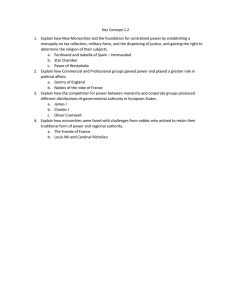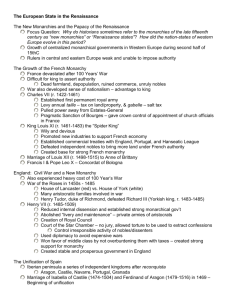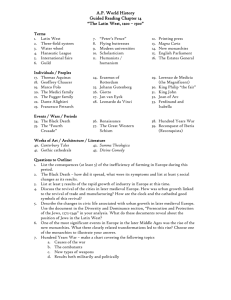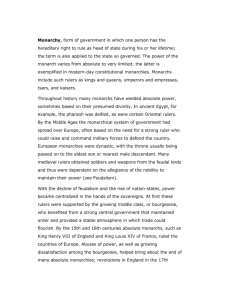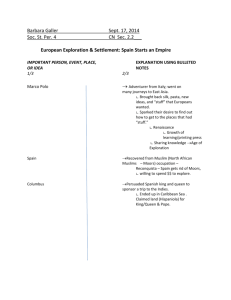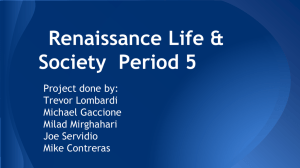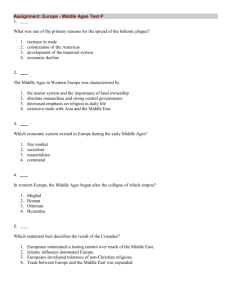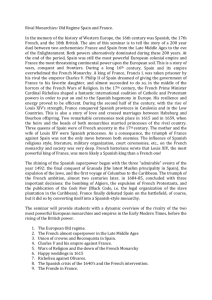Renaissance Monarchies General
advertisement
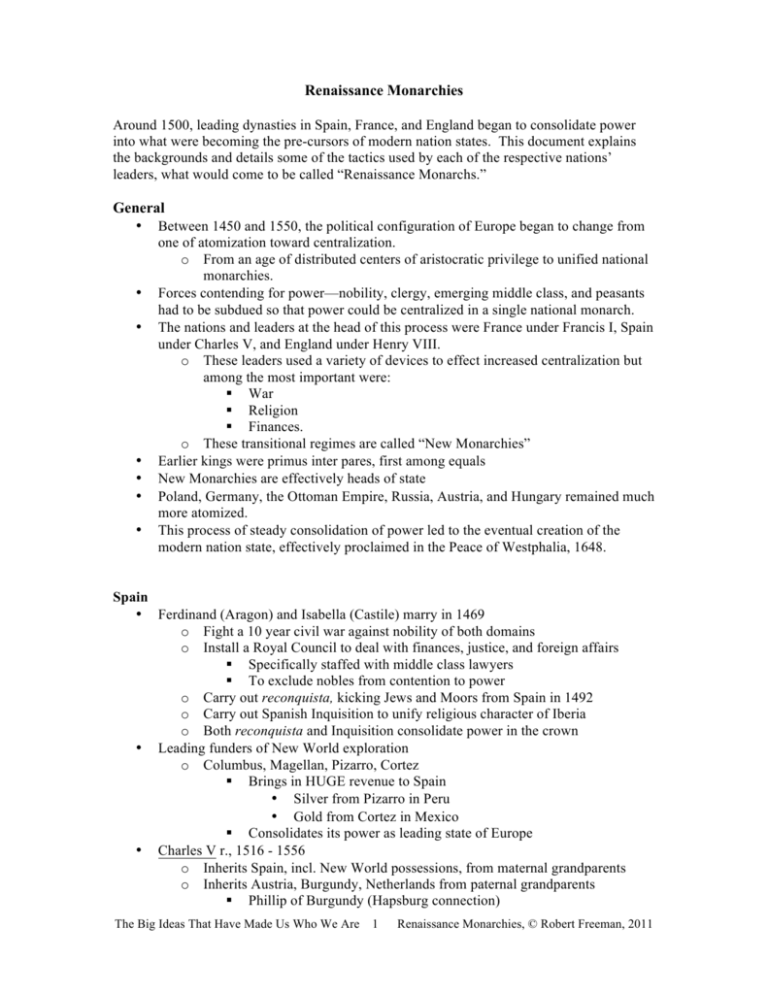
Renaissance Monarchies Around 1500, leading dynasties in Spain, France, and England began to consolidate power into what were becoming the pre-cursors of modern nation states. This document explains the backgrounds and details some of the tactics used by each of the respective nations’ leaders, what would come to be called “Renaissance Monarchs.” General • • • • • • • Between 1450 and 1550, the political configuration of Europe began to change from one of atomization toward centralization. o From an age of distributed centers of aristocratic privilege to unified national monarchies. Forces contending for power—nobility, clergy, emerging middle class, and peasants had to be subdued so that power could be centralized in a single national monarch. The nations and leaders at the head of this process were France under Francis I, Spain under Charles V, and England under Henry VIII. o These leaders used a variety of devices to effect increased centralization but among the most important were: § War § Religion § Finances. o These transitional regimes are called “New Monarchies” Earlier kings were primus inter pares, first among equals New Monarchies are effectively heads of state Poland, Germany, the Ottoman Empire, Russia, Austria, and Hungary remained much more atomized. This process of steady consolidation of power led to the eventual creation of the modern nation state, effectively proclaimed in the Peace of Westphalia, 1648. Spain • Ferdinand (Aragon) and Isabella (Castile) marry in 1469 o Fight a 10 year civil war against nobility of both domains o Install a Royal Council to deal with finances, justice, and foreign affairs § Specifically staffed with middle class lawyers § To exclude nobles from contention to power o Carry out reconquista, kicking Jews and Moors from Spain in 1492 o Carry out Spanish Inquisition to unify religious character of Iberia o Both reconquista and Inquisition consolidate power in the crown • Leading funders of New World exploration o Columbus, Magellan, Pizarro, Cortez § Brings in HUGE revenue to Spain • Silver from Pizarro in Peru • Gold from Cortez in Mexico § Consolidates its power as leading state of Europe • Charles V r., 1516 - 1556 o Inherits Spain, incl. New World possessions, from maternal grandparents o Inherits Austria, Burgundy, Netherlands from paternal grandparents § Phillip of Burgundy (Hapsburg connection) The Big Ideas That Have Made Us Who We Are 1 Renaissance Monarchies, © Robert Freeman, 2011 o Elected Holy Roman Emperor, 1519 § Commands greatest empire since Rome • Spain, Italy, Burgundy, Netherlands, Austria, New World • Managed from Castile by Hidalgo (middle class administrators). o Pact with Spanish Pope, Alexander VI, to appoint bishops seals relationship with Church § Also acts as gendarme for Church in wars against Muslims, Protestants France • Louis XI (Valois, Spider King) r., 1461 - 1483 o Begins consolidation of France after 100 Years War o Continues War-time taxes (gabelle: salt; and taille: property) § Uses proceeds to fund army • Combat nobles • Counter to independent urban centers o Defeats Burgundy, takes over land, consolidating further • Francis I, r. 1515 – 1547 o Financial: Used tax system to further centralize power § Centralized tax collections for all of France § Imposed new taxes § Raised old ones § Resulted in 3x increase in taxes collect by end of reign • A HUGE boost to centralized power o Religious: Concordat of Bologna, 1516 § Deal with Pope that Francis appoints bishops within France • Pope got first year revenues from tithes § Huge source of patronage authority § Huge source of cultural control § Shifts power from Church to Nation o Military: Constant use of war to consolidate power § Esp. against Hapsburgs in Italy • Pavia, 1521 – 25 • Cambrai, 1528 – 29 • Crepy, 1535 – 43 § Nobles required to serve in army • But exempted from taxes in exchange • Both had effect of reducing competing powers o Administrative: sold offices like never before § Customs, roads, tax collection, courts, etc. § Huge source of patronage • Putting his guys in positions of power throughout govt. § Short-term increase in monies o Total effect is massive consolidation of power into the central monarchy England • War of Roses (1455 – 1487) between competing dynasties after 100 Years War The Big Ideas That Have Made Us Who We Are 2 Renaissance Monarchies, © Robert Freeman, 2011 • o Lancaster family, headed by Henry Tudor, wins § Removes all French (Plantagenet) claims to English throne § Consolidates rule in single monarch, Henry VII Henry VIII (Tudor) r., 1509 – 1547 o Generally peaceful and prosperous reign § Unlike French and Spanish, little use of war • England is a discrete geography w/ unified language § Therefore little need for recourse to Parliament for loans § Peace and prosperity increase acceptance of reign o Begins by killing off all noble opposition § Use of infamous “Star Chamber” (sham trials) • Over 70,000 opposition killed in 38 year reign o Uses middle class as counter-weight to nobles § Justices of the Peace for local administration, loyalty § Borrowing for exigent expenses o Kicks out Catholic Church over divorce of Catherine of Aragon § Act of Supremacy, 1534 § Establishes Church of England with self as head • Confiscates Church lands • Distributes to friends § Removes another competing center of power § Increases control of critical cultural institution The Big Ideas That Have Made Us Who We Are 3 Renaissance Monarchies, © Robert Freeman, 2011
